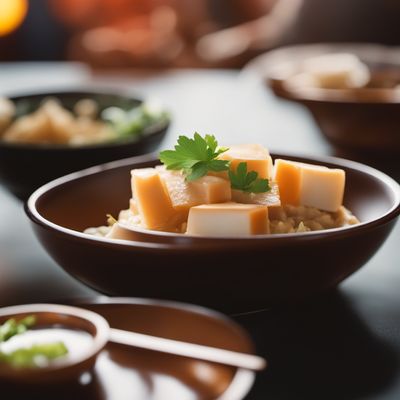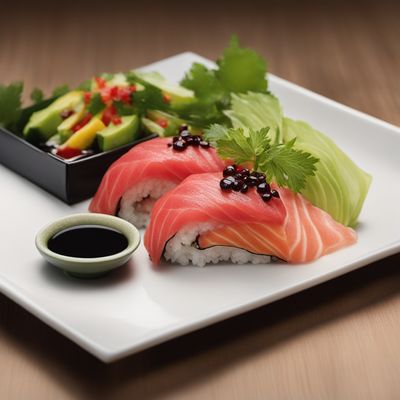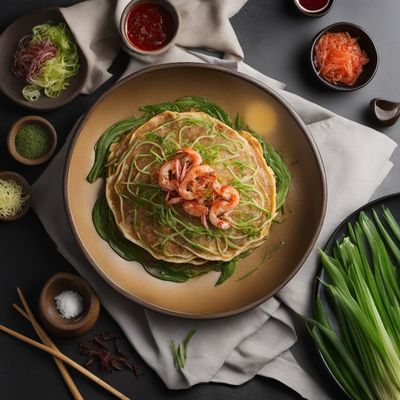
Recipe
Kohada Nigiri Sushi
Ocean Symphony Nigiri Sushi
4.7 out of 5
Indulge in the delicate flavors of Japanese cuisine with this exquisite Kohada Nigiri Sushi recipe. Made with fresh and flavorful ingredients, this dish showcases the artistry and precision of traditional sushi-making.
Metadata
Preparation time
40 minutes
Cooking time
N/A (No cooking required)
Total time
40 minutes
Yields
4 servings
Preparation difficulty
Medium
Suitable for
Pescatarian, Gluten-free, Dairy-free, Nut-free, Low-fat
Allergens
Fish (gizzard shad), Soy
Not suitable for
Vegan, Vegetarian, Paleo, Keto, High-protein
Ingredients
-
200g (7 oz) gizzard shad fish fillets 200g (7 oz) gizzard shad fish fillets
-
1/4 cup soy sauce 1/4 cup soy sauce
-
2 tablespoons rice vinegar 2 tablespoons rice vinegar
-
1 tablespoon sugar 1 tablespoon sugar
-
2 cups sushi rice 2 cups sushi rice
-
4 tablespoons rice vinegar (for seasoning the rice) 4 tablespoons rice vinegar (for seasoning the rice)
-
Wasabi paste, for garnish Wasabi paste, for garnish
-
Soy sauce, for dipping Soy sauce, for dipping
Nutrition
- Calories (kcal / KJ): 180 kcal / 753 KJ
- Fat (total, saturated): 1g, 0.2g
- Carbohydrates (total, sugars): 38g, 2g
- Protein: 4g
- Fiber: 1g
- Salt: 1.5g
Preparation
-
1.Rinse the gizzard shad fish fillets under cold water and pat them dry with a paper towel.
-
2.In a small bowl, combine the soy sauce, rice vinegar, and sugar to make the marinade.
-
3.Place the fish fillets in a shallow dish and pour the marinade over them. Ensure that the fillets are fully coated. Let them marinate for 30 minutes in the refrigerator.
-
4.Meanwhile, prepare the sushi rice according to the package instructions. Once cooked, transfer the rice to a large bowl and let it cool slightly.
-
5.Gradually add the rice vinegar to the cooked rice while gently folding it in with a wooden spatula. Be careful not to mash the rice.
-
6.Once the rice has cooled to room temperature, shape it into small oblong mounds using wet hands.
-
7.Take the marinated gizzard shad fillets out of the refrigerator and pat them dry with a paper towel.
-
8.Slice the fish fillets into thin strips, at an angle, to create beautiful diagonal cuts.
-
9.Place a slice of the marinated fish on top of each rice mound and gently press it down.
-
10.Serve the Kohada Nigiri Sushi with a small dollop of wasabi and a side of soy sauce for dipping.
Treat your ingredients with care...
- Gizzard shad fish — Ensure that the fish fillets are fresh and of high quality. The marinating process helps to enhance the flavor and texture of the fish, so allow enough time for marination to achieve the best results.
Tips & Tricks
- Use sushi-grade gizzard shad fish for the best flavor and texture.
- Wet your hands before shaping the sushi rice to prevent it from sticking.
- Adjust the amount of wasabi according to your preference for spiciness.
- Dip the fish side of the sushi into soy sauce to fully enjoy the flavors.
- Experiment with different sushi rice seasonings, such as adding a touch of mirin or sesame oil.
Serving advice
Serve the Kohada Nigiri Sushi as an appetizer or part of a sushi platter. Arrange the sushi pieces on a beautiful plate or sushi board, garnish with fresh herbs or edible flowers, and present it with elegance.
Presentation advice
To create an appealing presentation, arrange the Kohada Nigiri Sushi in a neat row on a rectangular plate. Place a small mound of pickled ginger on one end of the plate and a dollop of wasabi on the other end. Garnish with a sprinkle of sesame seeds or finely chopped chives for added visual appeal.
More recipes...
For Kohada nigiri sushi
More Japanese cuisine dishes » Browse all

Tofuyo
Tofuyo is a traditional Japanese dish made from fermented tofu. The dish is typically served as a side dish or snack and is popular in Japan.

Shogayaki
Ginger Pork
Shogayaki is a Japanese dish that is made with thinly sliced pork that is marinated in a mixture of soy sauce, ginger, and garlic. It is typically...

Matcha soba
Matcha Soba
Matcha soba is a Japanese noodle dish that is made with buckwheat noodles and matcha green tea powder. It is a unique and flavorful dish that is...





